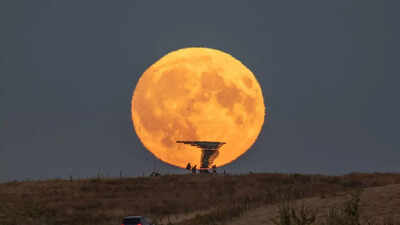
As autumn spreads its golden charm across fields, the night sky readies itself for one of its most captivating spectacles—the Harvest Moon. Unlike other full moons, the Harvest Moon holds a unique place in both tradition and astronomy, rising closest to the September equinox. Its glow has long guided farmers, once extending their harvest hours under its light, while also inspiring myths and stories across cultures. In October 2025, this rare celestial event will shine once again, later than usual, marking a special moment that occurs only occasionally. For skywatchers, the Harvest Moon is more than a bright disc in the sky—it is a reminder of the timeless bond between Earth’s changing seasons and the steady cycles of the cosmos.
Harvest Moon 2025: Date and time
Unlike other full moons of the year, the Harvest Moon holds a unique position in the lunar calendar. It is defined not by the month in which it appears, but by its proximity to the September equinox. In 2025, the Harvest Moon will grace the skies on 6 October, reaching its full phase at 03:48 GMT on 7 October.This timing makes the October 2025 Harvest Moon unusual. It falls just 14 hours and 39 minutes closer to the equinox than September’s full moon, pushing its appearance later than normal. Such a pattern occurs only 18 times in an 80-year span between 1970 and 2050. The last October Harvest Moon was seen in 2020, and after 2025, the next won’t arrive until 2028.
Who can witness the Harvest Moon 2025
The Harvest Moon is a spectacular celestial event that captivates skywatchers across the globe, but its visibility varies depending on location. Observers in the Northern Hemisphere are particularly favored, as the moon rises in the east and sets in the west, illuminating the night sky with its bright, silvery glow. The timing of moonrise during this period creates the unique impression of a steady, prolonged presence in the early evening sky. Optimal viewing requires clear weather, as clouds or heavy atmospheric conditions can obscure the moon’s brilliance.Visibility across IndiaIn India, skywatchers will have the chance to enjoy this rare full moon on October 6 and 7, 2025. The event can be seen from most regions, provided there is a clear view of the horizon. Both urban and rural locations can witness the moon, though darker areas with less artificial light will enhance the experience.
Harvest Moon tips to watch
To fully appreciate the Harvest Moon, select a location with an unobstructed eastern horizon, ensuring the moon rises without visual barriers like buildings or trees. While the moon is bright enough to be seen even in cities, areas with minimal light pollution offer the most striking views. No special equipment is required for casual observation, but using binoculars or a telescope can reveal the moon’s craters, maria, and surface features in greater detail.For both amateur skywatchers and experienced astronomers, the Harvest Moon is more than just a full moon—it is a connection to the rhythms of nature, a reminder of centuries-old traditions, and a stunning display that marks the changing of the seasons. Observing it can be a reflective, almost magical experience, linking the observer to the cycles of Earth and sky.
How the Harvest Moon guided farmers and shaped seasonal traditions
The name “Harvest Moon” dates back hundreds of years, rooted in agricultural traditions and seasonal cycles. Native American tribes, especially in the northern and eastern United States, gave each full moon a name that reflected the time of year and the work to be done.For farmers, this moon was a vital ally. Its bright glow allowed them to continue working after sunset, harvesting essential crops such as corn, beans, squash, and rice. This extra time in the fields often meant the difference between abundance and scarcity as winter approached.While many believe the Harvest Moon lingers longer in the sky than others, that distinction actually belongs to December’s full moon near the winter solstice. What makes the Harvest Moon special is its timing of moonrise. For several nights in a row, the moon appears near sunset, giving the impression of an almost constant presence in the twilight sky.
Science behind the Harvest Moon’s unusual moonrise
The magic of the Harvest Moon is not limited to its glow but also to its timing. Normally, the moon rises about 50 minutes later each evening. Around the Harvest Moon, this delay shortens dramatically.In Boston, the delay drops to just 24 minutes, offering a sense of consistency in evening brightness. In Miami, the difference averages 37 minutes, while in Edmonton, Canada, it is an astonishingly short 11 minutes.This phenomenon occurs because, during autumn in the Northern Hemisphere, the moon’s path—the ecliptic—forms a shallow angle with the horizon. The effect is reversed in the Southern Hemisphere, where the moonrise delay stretches beyond 80 minutes. Near the Arctic Circle, the pattern becomes even stranger. In Barrow, Alaska, the moon can actually rise earlier by about 43 minutes each night, creating a truly unique lunar display.
What skywatchers can expect this October
For modern stargazers, the Harvest Moon is less about agricultural utility and more about appreciating the beauty of celestial cycles. Its bright presence, rising close to sunset and lighting up the evenings for several nights, creates a sense of seasonal continuity.October’s Harvest Moon will not only bathe autumn landscapes in silver light but also remind observers of its deep ties to human history. Farmers once saw it as a signal to work longer hours in the fields, while today it serves as a natural invitation to step outside, look up, and reflect on our place beneath the stars.As the nights lengthen and the chill of autumn deepens, the 2025 Harvest Moon will symbolize both change and constancy—a timeless reminder that while the seasons shift, the celestial rhythms endure.Also Read | Hidden for millions of years: Rare Australian fragments reveal a lost ancient asteroid impact; crater mystery remains undiscovered








